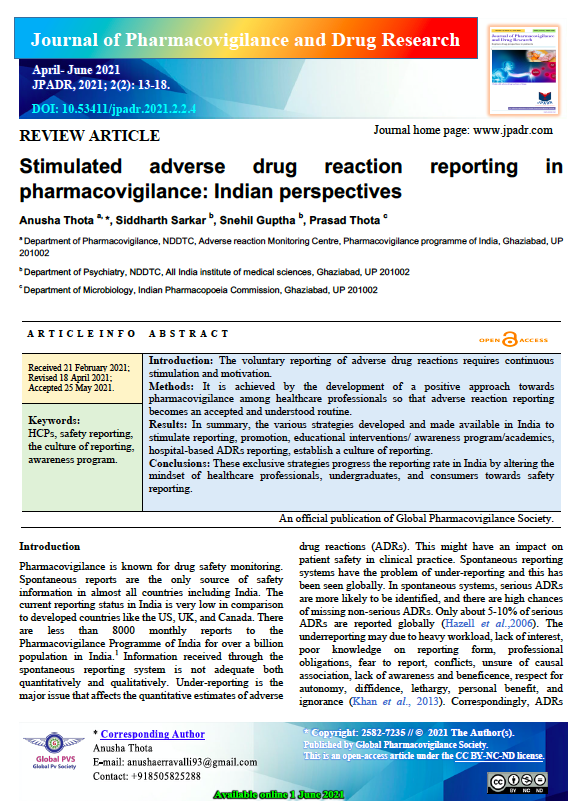Stimulated adverse drug reaction reporting in pharmacovigilance: Indian perspectives
Abstract
Introduction: The voluntary reporting of adverse drug reactions requires continuous stimulation and motivation.
Methods: It is achieved by the development of a positive approach towards pharmacovigilance among healthcare professionals so that adverse reaction reporting becomes an accepted and understood routine.
Results: In summary, the various strategies developed and made available in India to stimulate reporting, promotion, educational interventions/ awareness program/academics, hospital-based ADRs reporting, establish a culture of reporting.
Conclusions: These exclusive strategies progress the reporting rate in India by altering the mindset of healthcare professionals, undergraduates, and consumers towards safety reporting.
Downloads
References
Arici, M. A., Gelal, A., Demiral, Y., & Tuncok, Y. (2015). Short and long-term impact of pharmacovigilance training on the pharmacovigilance knowledge of medical students. Indian journal of pharmacology, 47(4), 436–439.
Cassels A. K. (2007). The media-medicine mix: quality concerns in medical reporting. Open medicine: a peer-reviewed, independent, open-access journal, 1(1), e52–e54.
Cassels, A., Hughes, M. A., Cole, C., Mintzes, B., Lexchin, J., & McCormack, J. P. (2003). Drugs in the news: an analysis of Canadian newspaper coverage of new prescription drugs. CMAJ: Canadian Medical Association journal = journal de l'Association medicale canadienne, 168(9), 1133–1137.
Dorsey, E. R., Rabbani, A., Gallagher, S. A., Conti, R. M., & Alexander, G. C. (2010). Impact of FDA black box advisory on antipsychotic medication use. Archives of internal medicine, 170(1), 96–103.
Edwards, I. R., & Lindquist, M. (2011). Social media and networks in pharmacovigilance: boon or bane? Drug safety, 34(4), 267–271.
Gavaza, P., Brown, C. M., Lawson, K. A., Rascati, K. L., Wilson, J. P., & Steinhardt, M. (2011). Influence of attitudes on pharmacists' intention to report serious adverse drug events to the Food and Drug Administration. British journal of clinical pharmacology, 72(1), 143–152.
George, C. (2006). Reporting adverse drug reactions, A guide for healthcare professionals. BMA board of science, 1-36.
Gony, M., Badie, K., Sommet, A., Jacquot, J., Baudrin, D., Gauthier, P., Montastruc, J. L., & Bagheri, H. (2010). Improving adverse drug reaction reporting in hospitals: results of the French Pharmacovigilance in Midi-Pyrénées region (PharmacoMIP) network 2-year pilot study. Drug safety, 33(5), 409–416.
Hazell, L., & Shakir, S. A. (2006). Under-reporting of adverse drug reactions: a systematic review. Drug safety, 29(5), 385–396.
Herdeiro, M. T., Polonia, J., Gestal-Otero, J. J., & Figueiras, A. (2004). Factors that influence spontaneous reporting of adverse drug reactions: a model centralized in the medical professional. Journal of evaluation in clinical practice, 10(4), 483–489.
Iaboli, L., Caselli, L., Filice, A., Russi, G., & Belletti, E. (2010). The unbearable lightness of health science reporting: a week examining Italian print media. PloS one, 5(3), e9829.
Indian Pharmacopoeia Commission. (2019). Retrieved from https://ipc.gov.in/PvPI/adr.html, last accessed on 26/11/2019.
IPC. (2019). NCC-Pharmacovigilance Programme of India. Recommendation letter to regulators. Sep 19, 2019, 1-6.
Jha, N., Rathore, D., Shankar, P., Gyawali, S., Hassali, M., Alshakka, M., Alshammri, T. (2015). Strengthening adverse drug reaction reporting in Nepal. Asian Journal of Medical Sciences, 6(4), 9-13.
Johansson, M. L., Hagg, S., & Wallerstedt, S. M. (2011). Impact of information letters on the reporting rate of adverse drug reactions and the quality of the reports: a randomized controlled study. BMC clinical pharmacology, 11, 14.
Khan, S. A., Goyal, C., Chandel, N., Rafi, M. (2013). Knowledge, attitudes, and practice of doctors to adverse drug reaction reporting in a teaching hospital in India: An observational study. Journal of natural science, biology and medicine, 4(1), 191- 196.
Klopotowska, J. E., Wierenga, P. C., Smorenburg, S. M., Stuijt, C. C., Arisz, L., Kuks, P. F., Dijkgraaf, M. G., Lie-A-Huen, L., de Rooij, S. E., & WINGS study group (2013). Recognition of adverse drug events in older hospitalized medical patients. European journal of clinical pharmacology, 69(1), 75–85.
Motola, D., Vargiu, A., Leone, R., Conforti, A., Moretti, U., Vaccheri, A., Velo, G., & Montanaro, N. (2008). Influence of regulatory measures on the rate of spontaneous adverse drug reaction reporting in Italy. Drug safety, 31(7), 609–616.
Moynihan, R., Bero, L., Ross-Degnan, D., Henry, D., Lee, K., Watkins, J., Mah, C., & Soumerai, S. B. (2000). Coverage by the news media of the benefits and risks of medications. The New England journal of medicine, 342(22), 1645–1650.
Pharmacovigilance Programme of India drug alerts. Retrieved from http://www.pvpi.in/das.html last accessed on 26/12/2019.
Pharmacovigilance Programme of India, ADR Reporting status. Retrieved from https://ipc.gov.in/PvPI/adr.html last accessed on 26/12/2019.
Pillans P. I. (2008). Clinical perspectives in drug safety and adverse drug reactions. Expert review of clinical pharmacology, 1(5), 695–705.
Rehan, H. S., Vasudev, K., & Tripathi, C. D. (2002). Adverse drug reaction monitoring: knowledge, attitude and practices of medical students and prescribers. The National medical journal of India, 15(1), 24–26.
Sloane, R., Osanlou, O., Lewis, D., Bollegala, D., Maskell, S., & Pirmohamed, M. (2015). Social media and pharmacovigilance: A review of the opportunities and challenges. British journal of clinical pharmacology, 80(4), 910–920.
Williams, D., & Feely, J. (1999). Underreporting of adverse drug reactions. Attitudes of Irish Doctors. Irish journal of medical science, 168(4), 257– 261.
Wong, C. K., Marshall, N. S., Grunstein, R. R., Ho, S. S., Fois, R. A., Hibbs, D. E., Hanrahan, J. R., & Saini, B. (2017). Spontaneous Adverse Event Reports Associated with Zolpidem in the United States 2003-2012. Journal of clinical sleep medicine: JCSM : official publication of the American Academy of Sleep Medicine, 13(2), 223–234.
Yong, P. L., Bigman, C., Flynn, D. N., Mittermaier, D., & Long, J. A. (2009). Messages about black-box warnings: a comparative analysis of reports from the FDA and lay media in the US. Drug safety, 32(12), 1147–1157.

Copyright (c) 2021 Anusha Thota, Siddharth Sarkar, Snehil Guptha, Prasad Thota

This work is licensed under a Creative Commons Attribution-NonCommercial-NoDerivatives 4.0 International License.









